| Pages:
1
2 |
MrHomeScientist
International Hazard
    
Posts: 1806
Registered: 24-10-2010
Location: Flerovium
Member Is Offline
Mood: No Mood
|
|
Copper Compound Reactions
Recently I've been trying to make a video for my YouTube channel about different copper compounds. The overall scheme was the following. In between
each step, the precipitate was filtered off and dried (except with CuCl2, that was left in solution).
1) CuSO4 + 2NaHCO3 == CuCO3 + Na2SO4 + CO2 + H2O
2) CuCO3 + 2HCl == CuCl2 + CO2 + H2O
3) CuCl2 + 2NaOH == Cu(OH)2 + 2NaCl
4) Cu(OH)2 + H2SO4 == CuSO4 + 2H2O
I thought it would be nice to end back at copper sulfate, which is where I started.
Anyways I went through this whole scheme but something went wrong on the final step. My copper hydroxide was filtered, washed, and dried so that I
could weigh it before adding the sulfuric acid. However, I seem to have trouble keeping Cu(OH)2 stable when drying and it had at least partially
decomposed to make the dry product a dark green instead of the turquoise blue it should be. I suspect it reacted with air into black CuO (which I've
seen happen before) and green CuCO3.
I wasn't too worried about this because sulfuric acid should react with any of these compounds to still produce copper sulfate, so I went ahead and
added the acid.
Here's what should have happened: Everything reacts and I am left with a blue solution of copper sulfate with no precipitate left over.
Here's what did happen: The solution is now green (similar to my CuCl2 soln) with a light blue precipitate remaining insoluble in the acid.
Any ideas to what might have been in my air-dried Cu(OH)2 that caused this? I thought that anything in there should have reacted away to CuSO4 in the
final step, but clearly something else is happening. I can post a picture of it when I get home tonight if that is useful.
--Edit--
One thought I had was the NaCl from step 3 might have reacted with sulfuric acid to make HCl, reacting with the Cu(OH)2 to bring me back to CuCl2,
which would explain the green solution. I washed my Cu(OH)2 a few times with distilled water though, so I can't imagine there was very much salt
contamination left in it.
[Edited on 5-20-2011 by MrHomeScientist]
|
|
|
Neil
National Hazard
   
Posts: 556
Registered: 19-3-2008
Member Is Offline
Mood: No Mood
|
|
Have you tried washing the remaining solids with strong HCl to see if it is copper chloride?
|
|
|
The WiZard is In
International Hazard
    
Posts: 1617
Registered: 3-4-2010
Member Is Offline
Mood: No Mood
|
|
Quote: Originally posted by MrHomeScientist  | Recently I've been trying to make a video for my YouTube channel about different copper compounds. The overall scheme was the following. In between
each step, the precipitate was filtered off and dried (except with CuCl2, that was left in solution).
1) CuSO4 + 2NaHCO3 == CuCO3 + Na2SO4 + CO2 + H2O
2) CuCO3 + 2HCl == CuCl2 + CO2 + H2O
3) CuCl2 + 2NaOH == Cu(OH)2 + 2NaCl
4) Cu(OH)2 + H2SO4 == CuSO4 + 2H2O
Anyways I went through this whole scheme but something went wrong on the final step. My copper hydroxide was filtered, washed, and dried so that I
could weigh it before adding the sulfuric acid. However, I seem to have trouble keeping Cu(OH)2 stable when drying and it had at least partially
decomposed to make the dry product a dark green instead of the turquoise blue it should be. I suspect it reacted with air into black CuO (which I've
seen happen before) and green CuCO3. |
Tooo much sodium hydroxide perhaps?
http://tinyurl.com/3v6d8sd
|
|
|
LanthanumK
Hazard to Others
  
Posts: 298
Registered: 20-5-2011
Location: New Jersey
Member Is Offline
Mood: No Mood
|
|
Is your H2SO4 pure? How long did you notice the light blue precipitate remaining insoluble?
|
|
|
MrHomeScientist
International Hazard
    
Posts: 1806
Registered: 24-10-2010
Location: Flerovium
Member Is Offline
Mood: No Mood
|
|
I performed a test on my unknown compounds, and here are the results (with pretty pictures!)
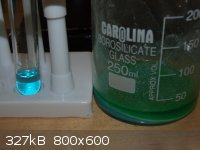
The beaker on the right is my concoction of unknown copper compounds. You can see the emerald green solution, with blue precipitate. There also
appears to be a thin layer of a whitish precipitate settled above the blue. It's been a few days, and everything remains insoluble. The solution is
still very much acidic with excess H2SO4.
The test tube on the left is the result of taking about 1mL of the green liquid and diluting it with a few mL of distilled water. Notice the color
change to blue - this is a strong indication that it is indeed copper chloride.
For further confirmation, I dissolved a very small amount of silver nitrate in 2mL distilled water, and added that to the test tube. Immediately a
white precipitate of silver chloride was observed, confirming the presence of the chloride ion. The solution is now a lighter blue, suggesting copper
nitrate (as it should be).
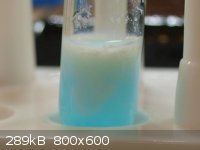 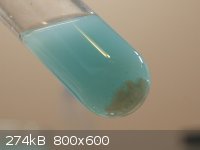
Conclusion: the green solution is definitely copper(II) chloride. The question remains though, how did this happen? Did the sulfuric
acid react with stray chloride ions from previous steps to somehow form HCl? That seems unlikely to me. There shouldn't have been much of that around.
And the second question remains: What is(are) the precipitate(s)?
===========Edit===========
I performed some tests on the precipitate, with interesting results!
I scooped some of the blue solid out of the bottom, placed it in a filter paper, and rinsed it with water to remove any of the green solution.
Surprisingly, all the solids dissolved!
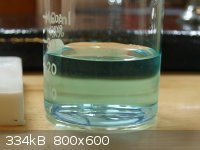
My blue crystals going easily into solution like this lead me to believe that this must be the copper sulfate I was looking for. So I transferred some
into two test tubes for testing.
To the left tube I added a small piece of iron wire. If this is indeed copper sulfate, copper metal will plate out on the iron as it displaces copper
in solution.
To the right test tube, I will perform an anion test, similar to what I did with silver nitrate above. This time I am looking for the sulfate ion, so
I made up a solution of barium chloride. If sulfate is present, a white precipitate of barium sulfate will form. Here's the two tests taking place:
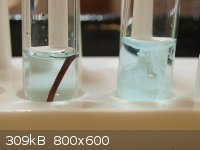
You can see the wire is visibly reddish, and a white precipitate immediately forms when BaCl2 is added to the right tube. Here's what everything
looked like after a few minutes reacting:
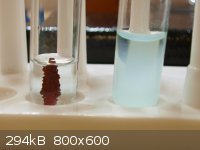 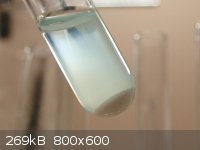
On the left, lots of copper plated out and the blue color of the solution cleared. On the right, white barium sulfate is observed.
Conclusion: The precipitate is indeed copper sulfate.
So, I ended up with a concentrated solution of copper(II) chloride with a precipitate of copper(II) sulfate. Apparently, the sulfate is not soluble in
a solution of the chloride. I'm still not really sure why this happened though. Adding sodium hydroxide in step 3 should have neutralized any
remaining hydrochloric acid and yielded NaCl, and washing the precipitate in step 4 should have carried away most or all of this salt. I would not
expect that there would be enough chloride left over to form such a concentrated solution of copper chloride.
That was pretty long-winded, but I enjoyed doing it. Anyone have any theories as to why this all happened?
[Edited on 5-21-2011 by MrHomeScientist]
|
|
|
MrHomeScientist
International Hazard
    
Posts: 1806
Registered: 24-10-2010
Location: Flerovium
Member Is Offline
Mood: No Mood
|
|
Edit: Sorry for the double post, I wanted to split up my comment replies from my experimental results.
Neil:
The copper chloride was soluble, and what was causing the green solution, so I don't think it'd be in the precipitate. I can try adding HCl to a
sample to see what it does.
The WiZard is In:
Interesting reference. Amazing what was around in the 40s! The article says that excess hydroxide shouldn't matter in the case of Cu(OH)2 though. When
I repeat this sequence of reactions it's probably smart to add the NaOH slowly anyway, so thanks for leading me to that bit of advice.
LanthanumK:
Pure enough I'd think, it's battery acid grade fresh from the bottle. I've never had any problems with it before. The precipitate has been sitting in
there like that for 3 or 4 days now, with no noticeable change.
Second edit: I've updated my post above to reflect new experimental results.
[Edited on 5-21-2011 by MrHomeScientist]
|
|
|
LanthanumK
Hazard to Others
  
Posts: 298
Registered: 20-5-2011
Location: New Jersey
Member Is Offline
Mood: No Mood
|
|
Did you produce http://en.wikipedia.org/wiki/Dicopper_chloride_trihydroxide instead of copper carbonate or copper hydroxide like you thought? This would explain
the results. The result after dissolving this in H2SO4 would be a mixture of CuCl2 and CuSO4. The common ion effect may precipitate the CuSO4 in a
concentrated H2SO4 and CuCl2 solution because CuCl2 is more soluble than CuSO4.
Too little sodium hydroxide may be your problem, rather than too much like the Wizard suggested above. Too much may make cuprates, though.
[Edited on 21-5-2011 by LanthanumK]
[Edited on 21-5-2011 by LanthanumK]
|
|
|
MrHomeScientist
International Hazard
    
Posts: 1806
Registered: 24-10-2010
Location: Flerovium
Member Is Offline
Mood: No Mood
|
|
That's really interesting LanthanumK, I hadn't heard of that compound before. I could easily see that happening with poor mixing of the solutions - I
bet some NaOH was trapped unreacted in the goopy Cu(OH)2 product. It's an interesting balance, can't have too much or too little. I think slow
addition might be the answer. I'll also probably just skip the drying step when I redo this, to ensure it doesn't oxidize in the air. Thanks for the
tip!
|
|
|
Random
International Hazard
    
Posts: 1018
Registered: 7-5-2010
Location: In ur closet
Member Is Offline
Mood: Energetic
|
|
Is there some interesting copper compound that can be made? I already made copper acetate crystals, have copper sulfate, made CuCl2 solution and half
a kilo of CuCO3. Now I don't know where to continue, any tips?
|
|
|
Mixell
Hazard to Others
  
Posts: 449
Registered: 27-12-2010
Member Is Offline
Mood: No Mood
|
|
You can try organo- metallic salts of copper, for example: Formate, oxalate, benzonate,citrate and much more.
Also compounds of the following type: Cs(x)CuM(2+x). Where X equals 1 or 2, and the M is a halogen anion (usually chloride, but sometimes iodide or
bromide). Also, you can try replacing the halogens with some other ligands, although it may be tricky.
|
|
|
kryss
Hazard to Self
 
Posts: 77
Registered: 11-7-2003
Location: N Ireland
Member Is Offline
Mood: No Mood
|
|
Copper Iodide is an interesting one as well as it instantly forms cuprous Iodide, if you have any Iodide of course.
|
|
|
sternman318
Hazard to Others
  
Posts: 121
Registered: 21-4-2011
Member Is Offline
Mood: No Mood
|
|
Tetraaminecopper(II) Sulfate
Eye catching to make! Adding small amounts of an ammonia solution to CuSO4 ( or any copper salt) turns dark blue-purple where the ammonia is poured,
then turns to pale copper hydroxide when stirred. Adding more ammonia eventually redissolves the Cu(OH)2 into the ammonia complex. Add some sort of
acid and you will get your CuSO4 back plus the ammonium salt of the acid, or adding NaOH will precipitate out the hydroxide again ( I believe)
[Edited on 18-7-2011 by sternman318]
|
|
|
ChemCrazy
Harmless

Posts: 3
Registered: 27-7-2011
Member Is Offline
Mood: No Mood
|
|
Grenn Solution
Green solution maybe is not copper chloride, maybe it is copper base carbonate, which is famous mineral malachite. I dont knew about it too. Once I
made experiment: electrolysis copper sulfate, i wanted to knew, that happened when SO4 is produced and the copper base carbonate produced, because of
high humidity and lot of CO2 is pruduced this salt. Actually copper carbonate is not dissolved in water, but copper base carbonate - Cu2CO3(OH)2,
malachite is dissolved and when heated it dissolved and produced carbon dioxide, water and copper oxide, so you can test your green solution: take not
many green solution, boil until powder will settle. Then heat powder and if it's colour will change to black, this water is with mineral malachite. If
not, it is copper chloride.
|
|
|
ChemCrazy
Harmless

Posts: 3
Registered: 27-7-2011
Member Is Offline
Mood: No Mood
|
|
Copper Salts
You can make: copper hydoxide - Cu(OH)2 with Copper Sulfate electrolysis in right conditions. Copper Oxide - CuO with heating Copper Carbonate or
copper heating under 100 Celsius. Copper Nitrate with reaction Copper to Dinitrogen tetroxide - N2O4 or copper to concentrated nitric acid.
|
|
|
Chemistry Alchemist
Hazard to Others
  
Posts: 403
Registered: 2-8-2011
Location: Australia
Member Is Offline
Mood: No Mood
|
|
What would be the best way to make Copper Nitrate without Nitric Acid?
|
|
|
blogfast25
International Hazard
    
Posts: 10562
Registered: 3-2-2008
Location: Neverland
Member Is Offline
Mood: No Mood
|
|
Probably calcium nitrate (an agricultural product) + copper sulphate:
Ca(NO3)2(aq) + CuSO4(aq) === > Cu(NO3)2(aq) + CaSO4(s)
But CaSO4 is still slighty soluble in water, so the copper nitrate will need recrystallising.
Copper salts can be obtained quite easily from copper (conductor) scrap, conc. H2SO4 ("Draino" et al) and hydrogen peroxide, search for Nurdrage's
CuSO4 Utoob vid, e.g.
|
|
|
kryss
Hazard to Self
 
Posts: 77
Registered: 11-7-2003
Location: N Ireland
Member Is Offline
Mood: No Mood
|
|
You will find Copper nitrate very hard to crystallise, it tends to hydrolyse as it gets concentrated, heated.
|
|
|
MrHomeScientist
International Hazard
    
Posts: 1806
Registered: 24-10-2010
Location: Flerovium
Member Is Offline
Mood: No Mood
|
|
Quote: Originally posted by kryss  | | You will find Copper nitrate very hard to crystallise, it tends to hydrolyse as it gets concentrated, heated. |
I've had that same problem. I had some copper nitrate left over from doing the "silver tree" demo and wanted to crystallize it, so I left it in a
Petri dish to evaporate. It never did, and I'm left with a few drops of extremely concentrated solution that refuses to crystallize.
|
|
|
cyanureeves
National Hazard
   
Posts: 737
Registered: 29-8-2010
Location: Mars
Member Is Offline
Mood: No Mood
|
|
i have quite a bit of copper compound left over from when i separate copper from sterling using nitric acid. i use the sodium chloride method to get
silver chloride in precipitate and leave the copper in solution. so what copper compound do i end up with? copper chloride? or both copper nitrate and
chloride? i started mixing copper compounds left over from both silver and gold extractions with aqua regia and i got a bottle full of a bright green
salt.if aqua regia makes gold chloride from 14kt. then the copper solution left over is also copper chloride isnt it?or is it copper sulfate if i drop
the gold with sodium metabisulfate? adding the sodium chloride to the nitrated sterling would also leave me with a copper chloride solution?
[Edited on 11-9-2011 by cyanureeves]
|
|
|
blogfast25
International Hazard
    
Posts: 10562
Registered: 3-2-2008
Location: Neverland
Member Is Offline
Mood: No Mood
|
|
Quote: Originally posted by kryss  | | You will find Copper nitrate very hard to crystallise, it tends to hydrolyse as it gets concentrated, heated. |
Wiki's solubility data on Cu(NO3)2 shows a very large difference in solubility between 100 C and 0 C. It should be possible to obtain crystals by
cooling a hot, saturated solution.
|
|
|
kryss
Hazard to Self
 
Posts: 77
Registered: 11-7-2003
Location: N Ireland
Member Is Offline
Mood: No Mood
|
|
To be fair i never tried seeding it, its been sitting in our shed for the last 5 years, still liquid and strangely enough with no dead spiders in!
|
|
|
TheNaKLaB
Hazard to Self
 
Posts: 51
Registered: 18-9-2011
Location: Australia
Member Is Offline
Mood: Elastic
|
|
@MrHomeScientist
I had the same problem when I was trying to make tetraaminecopper (II) Hydroxide.
I found that it worked well when I dissolved the Sodium Hydroxide in water then cooled it in the fridge for about an hour. I also cooled the Copper
Sulfate for the same time until they were the same temp. I reacted them together and precipitated Copper Hydroxide, which is the noticeable turquoise
colour.
|
|
|
blankets
Harmless

Posts: 6
Registered: 12-9-2011
Member Is Offline
Mood: No Mood
|
|
Hi all, long time lurker first time posting, blah, blah. I gotta say i luv these Cu complex's. Any one new to this should def start tinkering with the
Cu. Any how on to my question i made a saturatedsol of CuCl2 and evap'd down to get some damp evergreen colored crystals, after a lot of time n effort
i checked wiki and it says "CuCl2 may be purified by crystallization from hot dilute hydrochloric acid, by cooling in a CaCl2 ice bath" so it appears
i took the wrong route.
Does any one hear have exp forming CuCl2 crystalls? What do they mean when they say dilute HCl acid, how dilute?
I've attached an image (hopefully).
Wiki also describes the appearence as blue-green, im assuming mine are evergreen in color because their still moist? I started with CuSO4 then CuCo,
to the CuCl2, btw. thx
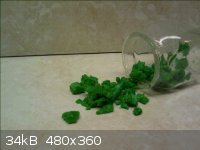
|
|
|
bbartlog
International Hazard
    
Posts: 1139
Registered: 27-8-2009
Location: Unmoored in time
Member Is Offline
Mood: No Mood
|
|
Looks a lot like my CuCl2. I think the issue that is being addressed by crystallization from dilute HCl is possible contamination with oxychlorides.
Like many other transition metal chlorides, CuCl2 will give off some HCl if you try to just heat to dryness from aqueous solution, i.e. you get a
small amount of Cu(OH)Cl mixed in with your CuCl2. I really think that in the case of CuCl2 this contamination is pretty minor, though; unlike ZnCl2
and some other strong Lewis acids, it can't attack water that easily.
|
|
|
AndersHoveland
Hazard to Other Members, due to repeated speculation and posting of untested highly dangerous procedures!
    
Posts: 1986
Registered: 2-3-2011
Member Is Offline
Mood: No Mood
|
|
Copper(II) nitrate trihydrate melts at 114 °C.
The anhydrous form cannot be obtained by heating the trihydrate, as it decomposes at the same time that the water is liberated.
The anhydrous form is a surprisingly reactive oxidizer.
I have tried reacting Cu metal foil with a solution of Cu(NO3)2, but there was not any reaction, even after several days.
Apparently Cu2O reacts with dilute HNO3 to form Cu(NO3)2 and copper metal.
http://www.ucc.ie/academic/chem/dolchem/html/comp/nitric.htm...
[Edited on 20-9-2011 by AndersHoveland]
|
|
|
| Pages:
1
2 |